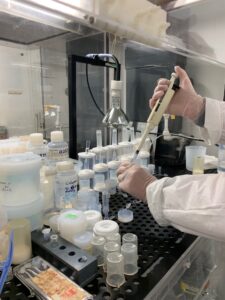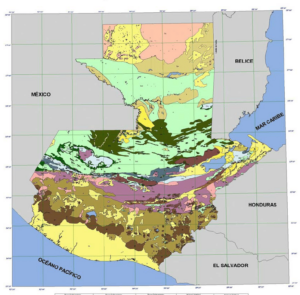- Home
- Projects
- Geology is life: fingerprinting the origin of human remains using geochemical techniques.
Geology is life: fingerprinting the origin of human remains using geochemical techniques.
- Year
- 2024
- Primary Supervisor
- Dr Jason Harvey <feejh@leeds.ac.uk>
- Institution
- University of Leeds (School of Earth and Environment)
- Possibility of becoming a CASE project.
- No
- Academic Supervisors
- Dr Evgenia Ilyinskaya <e.ilyinskaya@leeds.ac.uk> (Institute of Geophysics and Tectonics, School of Earth and Envrionment, University of Leeds)
- Research Themes
- Applied geoscience, Chemistry of the Earth
- Project Partners
- Dr Ryan Austin <ryan.austin@ntu.ac.uk> (Nottingham Trent University, Chemistry and Forensic Science)
- Research Keywords
- Chemistry, Geochemistry, Laboratory, Stakeholder Engagement
- Relevant Degree Courses
- Anthropology, Chemistry, Forensic science, Geochemistry, Geology
Project summary: The geochemist’s toolbox of elemental analysis, and stable and radiogenic isotopes systems has allowed scientists to track the movement of fluids, melts and rocks throughout Earth’s four and a half billion-year history. Problems associated with provenance and age of geological and environmental samples have been routinely investigated using geochemical techniques. Humans are rarely seen as geological or environmental samples in themselves, but the techniques applied to geochemical problems have great potential for tracing historical human migration and for use in a variety of forensic anthropology studies.

In this project, the successful candidate will have the opportunity to explore the utility of geochemical techniques in the analysis of human hair, teeth and bone. In geologically simple settings, the geochemical signature of bedrock and varying proximity to the coast often impart distinctive elemental and isotopic fingerprints upon foodstuffs derived from a particular region. This, in turn, has the potential to be incorporated in the teeth, hair and bone of humans indigenous to that area. Efforts to characterise this geochemical phenomenon in Guatemala has largely focused on archaeological populations, however within the Anthropocene, more globalised food networks dictate that direct sampling of modern individuals is required to reflect contemporary dietary practices. Building on a successful Sr isotope pilot study of hair samples from test subjects in Guatemala (Austin et al 2022), this project will investigate the utility of Sr, Ca and Pb radiogenic and S, O, N stable isotopes, and trace element compositions in fingerprinting the origin of indigenous people from various regions of Guatemala.
After decades of civil war, Guatemala has many historical mass graves, many of which contain the remains of indigenous people transported a significant distance from their homeland before their death. One possible outcome of this study would be to provide the Forensic Anthropology Foundation of Guatemala (FAFG) with a powerful toolkit enabling them to return the remains of indigenous people to their region of origin for burial in a more culturally appropriate manner. Characterising a modern Guatemalan population also has an international application, with the potential to help establish region of origin from the remains of border crossers in the US. While Mexico has been characterised extensively, countries such as Guatemala have been largely underexplored.
Impact: The reach of this research extends from national NGOs to national and international forensic organisations with cultural, societal and forensic implications. A multi-isotope approach will provide a rigorous matrix of bioavailable values to ascertain likely region of origin for unidentified individuals, strengthening forensic capacity, and representing the most comprehensive isotopic study in the country. Significantly, region of origin assessments are usually achieved through interpretation of degraded clothing, however geochemical proxies offer an empirical alternative.
Utilisation of C, N and S isotopes will provide an opportunity to establish socioeconomic differences between Mayan and Ladino populations, with this delineation an important factor in pursuing transitional justice.
Internationally the significance of this project will be through the facilitation of a greater understanding of the isotopic variability of Central America enabling international forensic actors to delineate between citizens of the respective countries in humanitarian crises (e.g., border crossers).
Culturally, geographically determined burial rights remain an integral part of Mayan culture. Resultingly, research outputs will contribute to ensuring individuals are returned to their region of origin to be afforded their specific burial rights according to their Mayan denomination.

Training: In addition to the comprehensive training in Cohort Building, Personal Effectiveness, Careers and Leadership, Communication & Policy and Data & Analytics provided by the Panorama DTP (details can be found here), the successful candidate can expect to be trained in a wide range of clean laboratory methods for the preparation of human remains for trace element, and stable and radiogenic isotope geochemistry. This will be complemented with training in instrumental techniques including scanning electron microscopy, inductively coupled plasma mass spectrometry (ICP MS), laser ablation ICP MS, stable isotope (C, N, S, O) analysis, and thermal ionisation mass spectrometry.
In order to understand the project holistically, the successful candidate will be given an opportunity to develop their knowledge of forensic anthropology through online training. They will also gain a broad understanding of where isotopes fit and are used within current disaster victim identification strategies and in cases of internationally displaced individuals. Additionally, the Guatemalan context will be explored so the chosen candidate is aware of the wider context in which their work operates and there will be the potential for collaboration with NGOs and international forensic organisations for the successful application to develop their network and contacts for post-PhD life.
No particular previous experience in the analysis of environmental or geological samples is necessary – all necessary training will be provided (…and if you can cook, you can do analytical chemistry) but the desire to complete a project that will be primarily laboratory-based is essential. This project would be particularly suitable for a numerate science graduate with a strong desire to test the limits of multi-disciplinary science.
The applicant should hold an interest in forensic science and knowledge of its application to human rights would be useful. Good communication skills, both written and oral are important, the applicant must be competent at explaining scientific procedures and results to those outside their respective field. The successful candidate will have to demonstrate a commitment to keeping stakeholders informed of the project’s development throughout its duration.
Eligibility: Please see the Panorama DTP eligibility criteria in the link to our Frequently Asked Questions here.
References: Austin et al (2022) Use of strontium isotope ratios in geolocation of Guatemalan population: Potential role in identification of remains. Journal of Forensic Science 67(5), 1962 – 1970. https://doi.org/10.1111/1556-4029.15116
